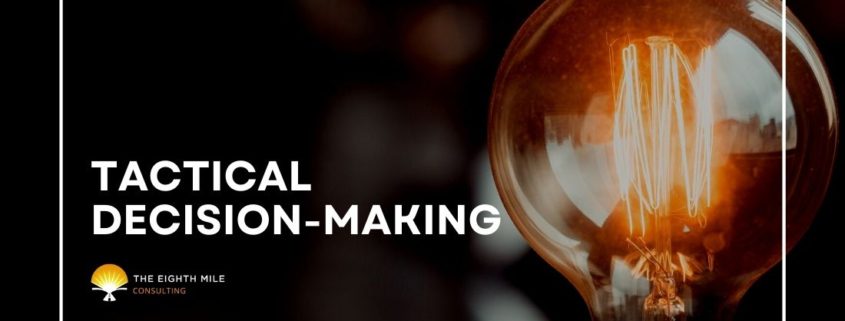Hear the phrase “tactical decision-making” and your first instinct is probably to frame it in terms of its strategic counterpart. This is not an article about strategy, but there is an important habit we need to bring with us from setting strategy when we think about tactics: thinking. No one reading this would let strategy decide itself or claim that strategy emerges from reacting to crises. Management by exception has its place, but it won’t set your strategy for you. Neither, more to the point, is it appropriate to let our reflexive reactions to events dictate our tactics.
What Is Tactical Decision-Making?
Put simply, tactical decision-making is thinking through your day-to-day operations, with an emphasis on taking responsibility and control over improving the way you and your team get things done.
Tactical decision-making is easier to understand in terms of what it is not. If you are running on autopilot, spectating your metrics, or responding reflexively to events, you are not engaging in tactical decision-making.
Running on Autopilot
“A foolish consistency is the hobgoblin of little minds …” -Ralph Waldo Emerson
“Running on autopilot” is doing what you did because it is what you have done. Maybe you looked at your metrics first, or you see that your customers and team are happy, or perhaps you’ve thought through what you’re doing extremely well, and that’s why it works. But nothing works the same way forever. And was it not tactical decision-making that led you to such a smooth-running operation in the first place?
Responding Reflexively to Events
We must respond to events, but if we’re letting events dictate our reactions, repetition will turn those reactions into policy. When we find ourselves reacting to the same crises, know that we are creating policy whether we think it through or not. A leader sets policy with intention; a follower is led into policy unaware.
“Fear is the mind-killer.” -Frank Herbert, Dune
Nothing sets the reflexes in gear and the mind in neutral like fear. Despite the note of urgency of the metaphor of putting out fires, most leadership crises aren’t so critical that we can’t afford to think before we act. One way to create some space is not to fight the fear but embrace it as problem-solving urgency. When you feel that pit opening in your gut, stop. Take a moment to absorb the situation. Consider your options, pick one, and then proceed. If your “fight or flight” response is set to “fight” and the way you fight is to “solve,” you’ve set yourself up for problem-solving over panic.
It also helps to try to anticipate time-constrained problems before they arise. Of course, no one can predict everything. The best we can do is learn from experience and never be taken by surprise twice.
A Spectator to Your Metrics
You’re close to tactical decision-making, but you’re not quite there. You’re looking at your financials, tracking your project’s critical path, and checking your metrics. You’re keeping track of your progress, whatever form that takes. Fantastic! How are you acting on those metrics? Running on autopilot? Reacting reflexively? Or are you really using your tools to make good decisions?
Tactical Decision-Making
You have the metrics and the mindfulness to actively choose to make or remake operational decisions. You’re looking at your processes, policies, and methods and asking yourself, “How can I make this better?” You’re thinking and acting, not responding reflexively. This is tactical decision-making.
Balance: Management by Exception vs. Tactical Decision-Making
We have many duties as leaders, and no advice we take or method we employ should ever draw us away from keeping our responsibilities balanced. Tactical decision-making should never be a reason not to give prompt attention to immediate needs and emerging problems.
When Tactical Decision-Making Is an Excuse
Everyone has worked with — or worse, for — a Laputan so wrapped up in abstract ideas you can count on this person to do no actual work. Such a person might even hijack a meeting to discuss a concept in uselessly abstract terms or quibble over issues not related to the work at hand. The Laputan will also talk a lot about “vision,” “strategy,” and perhaps even “tactical decision-making.”
Obviously, a good leader has to dig in and do the work. A good leader must respond promptly to crises, particularly those involving customers or legal affairs. A good leader needs to be in the moment when the situation demands it. “Don’t bother me; I’m thinking,” isn’t an acceptable excuse when you are needed. When we lead a meeting, we need to justify every minute we hold the floor to justify the time cost for every person there, including ourselves.
When Management by Exception Is an Excuse
The customer walks away happy, the dispute between the employees dissolves before your wisdom, the blockage in the production line bursts open at your command, and you feel pretty good about that. “I’m doing a great job!”
Yes, you did a great job and have every right to feel proud. But you’re a leader, and a leader has many responsibilities. If we never think about tactical decision-making, if we never think about underlying processes, some of which might well be contributing to the fires we’re constantly putting out, we are neglecting one of our duties as a leader. It costs us time, but intelligently addressing the cause of a problem saves us the time of repeatedly solving that problem.
Conclusion
Tactical decision-making is as important as responding promptly to the immediate challenges of our leadership environment. A wise leader understands and carries the burdens of both planning and execution. Find the right balance between responding to events as a leader and taking time to think through the day-to-day work processes so that “emergencies” and “exceptions” become fewer as our plans for dealing with them become better.
The Eighth Mile offers an online leadership training course to help find balance and think and act like a leader. Get in touch to find out how to can improve decision-making processes.



 The Eighth Mile Consulting
The Eighth Mile Consulting  The Eighth Mile Consulting
The Eighth Mile Consulting 
 The Eighth Mile Consulting
The Eighth Mile Consulting 

Leave a Reply
Want to join the discussion?Feel free to contribute!